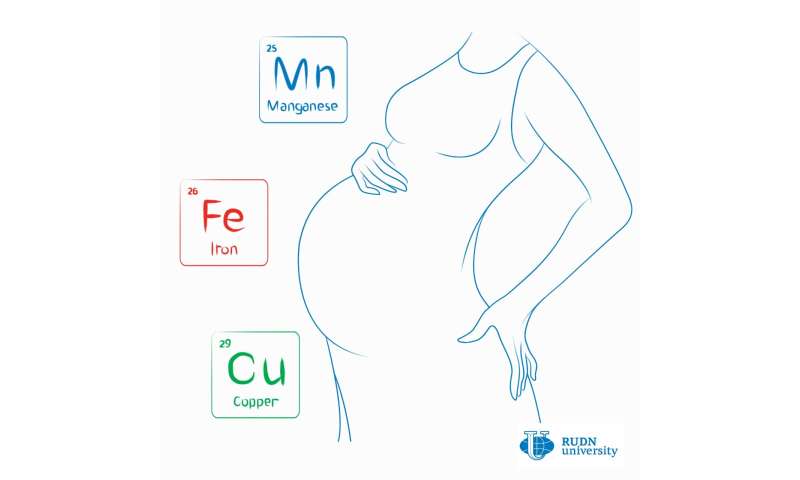Lack of copper and excess of iron in blood are markers of reproductive problems in women, physicians find

RUDN University physicians report that low copper levels and higher than normal levels of iron in the blood of women can be associated with miscarriages, infertility and some other reproductive problems. The study is published in the Journal of Trace Elements in Medicine and Biology.
Lack and excess of trace elements in the body can lead to health problems. This is especially important to observe in pregnant women. In their body naturally raises the level of some elements, in particular, iron, manganese, and copper, so as this needs for normal fetal growth. The lack of these nutrients is associated with miscarriages or intrauterine growth retardation of the unborn child.
Earlier, a group of RUDN University physicians together with specialists from Taipei Medical University (Taiwan) and Sechenov University under the leadership of Anatoly Skalny found that women who can not get pregnant and have to resort to in vitrofertilization, there is a deficit of some trace elements—in particular, copper, iron, silicon, zinc, magnesium. Now the same group decided to check how the levels of iron, manganese, and copper in the blood are correlated with pathologies in the reproductive sphere—miscarriages and primary infertility.
"This study is one of the stages of our global project to explore the role of trace elements in reproductive health. Its final goal is the identification of the most important metabolic disorders of micronutrients in women of reproductive age, personalized correction which will reduce the risk of infertility, pregnancy complications, developmental disorders associated with nutritional factors,"—study's lead author Anatoly Skalny, professor of medical institute of RUDN University.
The study involved 485 people. In the control group, there were 150 nonpregnant women,169 pregnant women, 91 with infertility, 75 women who had a miscarriage shortly before the study. They were all about the same age—about 33-35 years old—and with roughly the same body mass index—about 21-22, which is normal. Each woman took a blood sample from which was separated serum and was measured the levels of iron, manganese, and copper by Inductively Coupled Plasma
Mass Spectrometer. The results of different groups—non-pregnant, pregnant and having pregnancy pathology were compared with each other.
In pregnant women, compared with the control group, copper and manganese levels were significantly increased—by 40 percent and 16 percent, respectively. At the same time, compared to pregnant women, copper levels were reduced in women with miscarriages and infertility—by 30 and 35 percent, respectively. In addition, miscarriages were associated with a 13 percent increase in blood iron levels compared to healthy pregnancies—Alexey Tinkov, coauthor of the study comments.
"Despite the fact that iron is the most important element and the frequency of its deficiency and iron deficiency anemia in pregnancy is extremely high, it is necessary to avoid not only its deficiency, but also excess, which can be accompanied by toxic manifestations. Therefore, the intake of iron-containing drugs should take place under strict control of laboratory parameters"—Alexey Tinkov, an employee of the Medical Institute of the RUDN University, comments.
Then physicians used methods of statistics (regression analysis) and have identified, is the increased or decreased level of these trace elements in the blood and a healthy pregnancy interrelated. It turned out that there is an interrelation. The higher the copper level, the lower the probability of pregnancy pathologies. Iron and manganese levels, when considered separately from copper, are not particularly related to reproductive health, but they are still higher in pregnant women than in nonpregnant women.
RUDN University physicians concluded that the increased concentration of iron and reduced concentration of copper can be associated with miscarriages and infertility. Also important attention should be paid to the control of iron metabolism, avoiding not only its deficiency, but also excess. But to prove that there is a causal link, additional clinical studies are needed.
"The study suggests a significant role of copper during pregnancy, which is primarily important for clinical practice. It is expected that women with copper deficiency are at risk of reproductive disorders, correction of copper metabolism can significantly reduce these risks. At the same time, taking into account the potential harm of excess copper, iron, or any other trace element or biologically active substance, the correction of trace element metabolism should be personalized, based on the assessment of copper metabolism in the body of a woman"—Anatoly Skalny concludes.
More information:
Margarita G. Skalnaya et al. Serum levels of copper, iron, and manganese in women with pregnancy, miscarriage, and primary infertility, Journal of Trace Elements in Medicine and Biology (2019). DOI: 10.1016/j.jtemb.2019.08.009
Provided by RUDN University